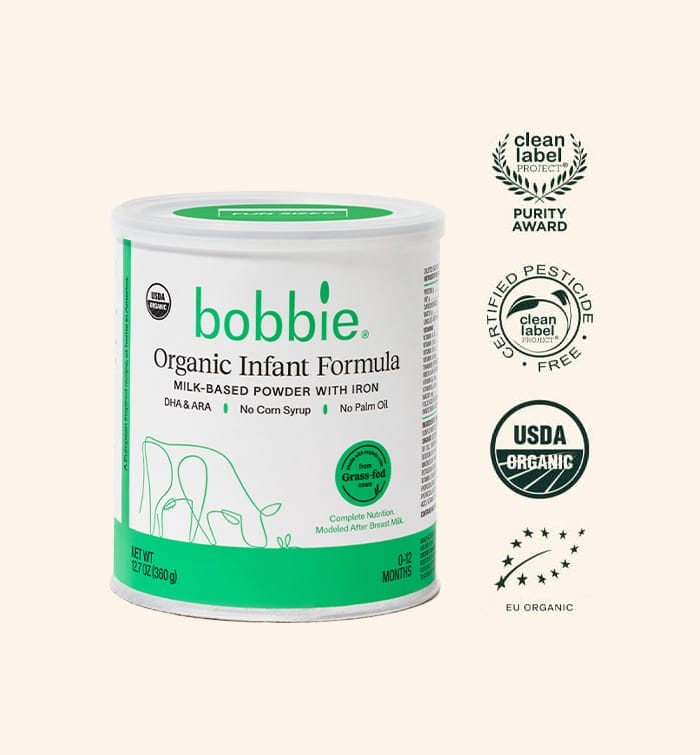We are proud to say that these posts are not sponsored. Our editorial team of Bobbie moms and writers personally select each featured product. If you buy something through our links, we may earn an affiliate commission, at no cost to you.
Breastfeeding offers many health benefits to infants and moms, but there are times when breastfeeding is not recommended or not possible.1 Whether you’re looking to supplement a low breast milk supply with high quality infant formula, want to combo feed when returning to work, or transition off breastfeeding entirely, let’s walk through all of your options to help you decide what’s best for you and your baby.
- When is breastfeeding not recommended?
- Why supplement with formula or stop breastfeeding?
- What can I use to supplement or feed my baby if I can’t breastfeed?
- Which formula is best for a breastfed baby?
- Is infant formula safe?
- What are the different types of infant formula?
- Which infant formula is best for a breastfed baby?
- How to introduce formula to a breastfed baby
- Successful supplementing with formula
When is breastfeeding not recommended?
Certain medical conditions in mom or baby may mean that breastfeeding is not the best option. Moms with certain infectious diseases like HIV and those who are very sick with any disease may not be recommended to breastfeed. Certain medications can also be dangerous when passed from breast milk to babies, so moms taking these medications are often recommended not to breastfeed.2 This is why it’s important to talk about all of your medications and medical issues with your doctor and your baby’s healthcare provider so you can decide what’s best for you.
Infants with certain rare genetic disease and those who are born prematurely may need different or extra kinds of nutrition. Some may not be able to breastfeed at all and some may just need an extra way to get more calories for a short time.2 Again, your baby’s healthcare provider should always be the one guiding you if this is the case for your baby.
Why supplement with formula or stop breastfeeding?
This one is a little more complicated than the reasons for not breastfeeding at all. Choosing not to breastfeed all the time, whether you supplement with breast milk or baby formula, is a choice parents make for a lot of reasons, both personal and medical.
Some of the most common reasons parents choose to supplement or stop breastfeeding include:3
- Problems with breastfeeding or latching
- Worries about your baby’s weight
- Concerns about a medication you are taking
- Issues related to breastfeeding at work, like breastfeeding and maternity leave policies
- Lack of support from loved ones
So what can I use to supplement or feed my baby if I can’t breastfeed?
Great question! There are actually more supplementing options than you may think. Depending on the reason for supplementing or stopping breastfeeding, these include offering a bottle of pumped breast milk, using pasteurized donor breast milk and using infant formula.4
There are pluses and minuses to all of these options. For example, if you can offer pumped (also called expressed) breast milk, then your baby can still get some of the health benefits of breastfeeding. However, if you need to stop breastfeeding because of a medication you need to take, this doesn’t solve your problem and formula may be the best option. Again, talking with your doctor, your baby’s healthcare provider and/or a lactation consultant can help you understand all of your options and what’s best for you and your baby.

Shop Bobbie Organic Infant Formula
Bobbie Organic Infant Formula is a USDA Organic, EU-style infant formula that meets all FDA requirements. It is a complete nutrition milk-based powder modeled after breast milk and is easy on tummies. It is non-GMO and doesn't have corn syrup, palm oil, or maltodextrin. Learn more about Bobbie.
Which formula is best for a breastfed baby?
This is such a common question for parents, so you’re in good company if you’re wondering this. If you were already breastfeeding, it’s probably because you knew the health benefits for your baby and you want to keep doing what’s best for them when you can’t offer breast milk. And even if you were never able to breastfeed, you still want to know which baby formula is the best option for your baby.
First, let’s cover a few basic formula facts.
Is infant formula safe?
Infant formulas that are legally sold and marketed in the US are regulated by the Food and Drug Administration (FDA) to ensure their safety. FDA sets minimum levels for 30 nutrients and maximum levels for 10 of those nutrients in infant formula. Although FDA does not approve every formula in the US before it goes on the market, all companies are required to notify FDA with proof of meeting these requirements before marketing their formula.5
Of note, this means that generic formula brands legally sold in the US are just as safe as brand names, since they are all regulated by FDA.6
On the other hand, homemade infant formula and formulas that are imported from other countries and not regulated by FDA may not be safe. The American Academy of Pediatrics (AAP) recommends against using either of these kinds of formula.7 This includes European baby formula not approved by FDA.
What are the different types of infant formula?
Although there are SO many formula brands and formulations, including organic formula and nonorganic formula, all formulas more or less fall into these 3 baby formula categories:8,9
- Milk-based formula: Most infant formula sold in the US is cow’s milk-based. It’s important to know that even though these formulas are “cow’s milk-based” they are processed to meet the needs of infants and simulate breast milk as much as possible, so they are very different from the cow’s milk you get in a carton at the grocery store.
- Soy-based formula: This is just like it sounds- soy-based formula contains soy protein like the adult versions of soy milk you may be familiar with. However, just like milk-based formulas, these formulas are processed and have added ingredients to make them safe for babies, so they are very different from the soy milk you may drink.
- Hypoallergenic formula: These formulas may be protein hydrolysate (meaning the protein is broken down into much smaller pieces than in milk- or soy-based formula) or amino acid (without protein peptides) formulas.
So which infant formula is best for a breastfed baby?
If you’re wondering which formula is best for a breastfed baby who needs to supplement or transition— well, it depends. For the most part, a milk-based formula is often the best place to start. It’s important to remember that the AAP recommends that all infants who are not breastfed or only partly breastfed receive iron-fortified formula. This helps to prevent anemia (low blood iron levels) in babies.9
There are some times when a milk-based formula is not the best option. For example, if your baby has been diagnosed with a disease called galactosemia, then soy-based formula is usually recommended. Families who adhere to vegan diets may also choose a soy-based formula.9
Babies with an allergy to cow’s milk will also need special consideration when choosing an infant formula. Since some babies with a milk allergy are also allergic to soy, a hypoallergenic formula may be recommended for these infants.9
Bottom line- always talk to your baby’s healthcare provider before choosing a formula. Beyond the types of formula discussed here, there may also be considerations for different formulations for your baby’s needs. For example, if your baby was born prematurely, they may need a special formulation with extra calories or vitamins to support their nutritional needs.9
How to introduce formula to a breastfed baby
Lots of parents want to know exactly how to introduce formula to their baby who’s only ever breastfed. You might be worried they won’t like the taste or want to make sure you get the most out of the breast milk you are still giving them. Here are a few tips to make the transition easier:
- If you’re still doing some breastfeeding or offering breast milk from a baby bottle, continue to do this before offering any formula if you are giving both at the same feeding. Make the formula in a separate bottle. If you mix breast milk and formula together in a bottle, you risk having to throw out some of that precious breast milk if your baby doesn’t finish the bottle.4
- If you plan to continue some breastfeeding, try paced bottle feeding when you start formula feeding. This method makes bottle feeding move at a pace similar to breastfeeding so your baby doesn’t start to prefer the faster pace of bottle feeding.4
- If possible, take the process slowly to allow time for your baby to adjust. You can start by replacing one feeding per day with a formula bottle. After a few days or a week, you can add one more, and so on.10
- Try letting someone else (like your partner or other family member) offer the formula bottle to your baby. Sometimes babies associate your smell with breastfeeding, so they are less likely to want a formula bottle from you.11
- If you are weaning your baby off breastfeeding, try starting with their “least favorite” feeding of the day. In other words, you might not want to start with the nighttime feed that your baby uses to comfortably drift off to sleep.11
- Try to sit somewhere new when you start bottle feeding. Your usual recliner, couch, or favorite breastfeeding spot may give your baby cues that you are about to breastfeed.11
- If possible, try not to start the switch to formula bottles when your baby is sick, teething, starting daycare or going through some other type of change. Too many changes or differences at once can be stressful for a baby and may make the transition harder.11
Successful supplementing with formula
There are always bound to be bumps in the road when changing your baby’s feeding routine, but with preparation and some patience, you can supplement breastfeeding in the way that works best for you and your family. Remember to check in with your baby’s healthcare provider first, keep them up-to-date on how it’s going, and reach out to them whenever you need help along the way.

Shop Bobbie Organic Infant Formula
Bobbie Organic Infant Formula is a USDA Organic, EU-style infant formula that meets all FDA requirements. It is a complete nutrition milk-based powder modeled after breast milk and is easy on tummies. It is non-GMO and doesn't have corn syrup, palm oil, or maltodextrin. Learn more about Bobbie.
Sources:
1- Breastfeeding recommendations and benefits | Centers for Disease Control and Prevention
2- Acceptable medical reasons for use of breast-milk substitutes | World Health Organization
3- Breastfeeding facts | Centers for Disease Control and Prevention
4- Mixing milk | La Leche League International
5- Questions & answers for consumers concerning infant formula | Food and Drug Administration
6- Infant formula: your questions answered | Mayo Clinic
7- Choosing an infant formula | Centers for Disease Control and Prevention
8- Review of infant feeding: key features of breast milk and infant formula | Nutrients
9- Choosing an infant formula | American Academy of Pediatrics
10- Weaning | Centers for Disease Control and Prevention
11- Weaning your child | Nemours Kids Health

